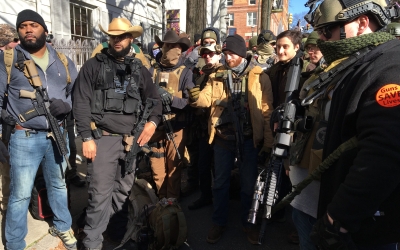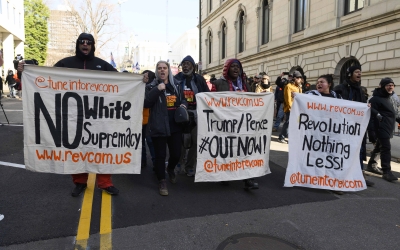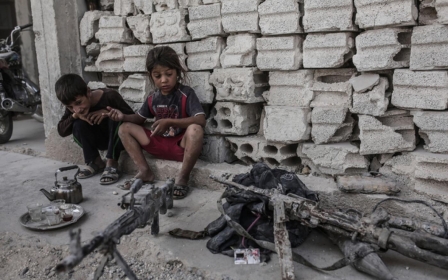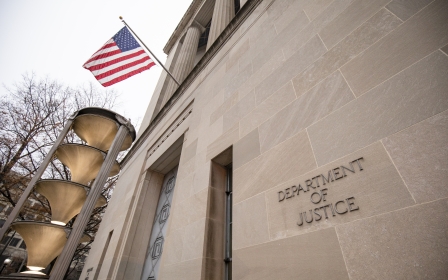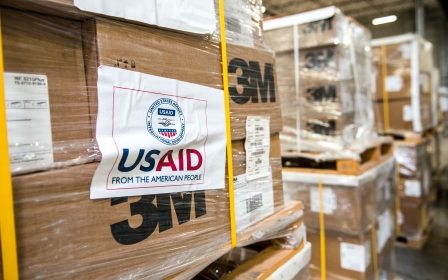White supremacists more of threat to US than IS or al-Qaeda, security agency says

White supremacists are "the most lethal threat" to the United States, worse than the Islamic State (IS) group and al-Qaeda, according to several recently obtained Department of Homeland Security (DHS) draft documents.
The recent draft reports, first obtained by Politico, said white supremacists would continue to be the most "persistent and lethal threat" in the United States through 2021.
"Foreign terrorist organizations will continue to call for Homeland attacks but probably will remain constrained in their ability to direct such plots over the next year," all three drafts say.
The report predicts an "elevated threat environment at least through" early next year and warns that US-based violent extremists are taking advantage of increased social and political tensions this year.
A DHS spokesperson declined to comment to Politico over the "allegedly leaked documents".
Former acting DHS secretary Kevin McAleenan directed the agency last year to start producing such threat assessments annually. The final 2020 threat assessment has not been publicly released.
The drafts of this year's assessment, however, are particularly worrying, given the months-long anti-racism protests that have erupted across the United States since the May police killing of George Floyd, an unarmed Black man who was slain while being detained for allegedly trying to use a fake $20 bill at a convenience store.
US President Donald Trump has done little to quell the racial unrest, instead choosing to emphasise his support for "law and order".
Violence against anti-racist protesters
Last month, Kyle Rittenhouse, a 17-year-old Trump supporter, fatally shot two protesters and wounded another during an anti-racism demonstration in Kenosha, Wisconsin, which broke out after police shot another Black man in the back seven times. Rittenhouse has since been arrested and charged.
Following the deadly event, the US president not only declined to condemn right-wing violence at protests, he voluntarily defended it.
“That was an interesting situation. You saw the same tape as I saw,” he said, referring to footage of the incident that shows Rittenhouse shooting a second victim, who was seemingly attempting to disarm him after he'd already killed another protester.
"He (Rittenhouse) was trying to get away from them. I guess it looks like he fell and then they very violently attacked him. And it was something that we’re looking at right now, and it’s under investigation. But I guess he was in very big trouble. He would have been - probably would have been killed, but it’s under investigation."
As DHS narrows in on right-wing white supremacists, Trump has instead chosen to focus on the broad and loosely knit anti-fascism group "Antifa" and other so-called anarchist groups he alleges are being indoctrinated by the progressives.
While intelligence agencies have yet to report a real threat risk from those associated with Antifa, in May President Trump tweeted that he planned to designate the group a terrorist organisation.
Trump's lack of condemnation of white supremacist violence goes back further than the recent domestic upheaval. In 2017, right-wing extremists, some of whom were affiliated with a neo-Nazi movement, sparked violence via a counter-protest in Charlottesville, Virginia, killing one left-wing protester with a car. After the killing Trump told reporters that there were some "fine people" on both sides.
In February, the Anti-Defamation League's Center on Extremism reported that incidents of white supremacist propaganda being distributed in the US jumped by more than 120 percent in 2019 from 2018.
In addition to the threat posed by white supremacist groups, the recent DHS threat assessment drafts also warn against continued disinformation efforts by Russia.
According to the report, Russian state-affiliated actors will continue to target American industries and all levels of government with "intrusive cyber espionage" operations.
"Russia probably will be the primary covert foreign influence actor and purveyor of disinformation and misinformation in the Homeland," the reports read, with Moscow's primary aim believed to be undermining the US electoral process.
According to the drafts, China and Russia are the biggest threats to cybersecurity, ahead of Iran and North Korea.
Middle East Eye delivers independent and unrivalled coverage and analysis of the Middle East, North Africa and beyond. To learn more about republishing this content and the associated fees, please fill out this form. More about MEE can be found here.


